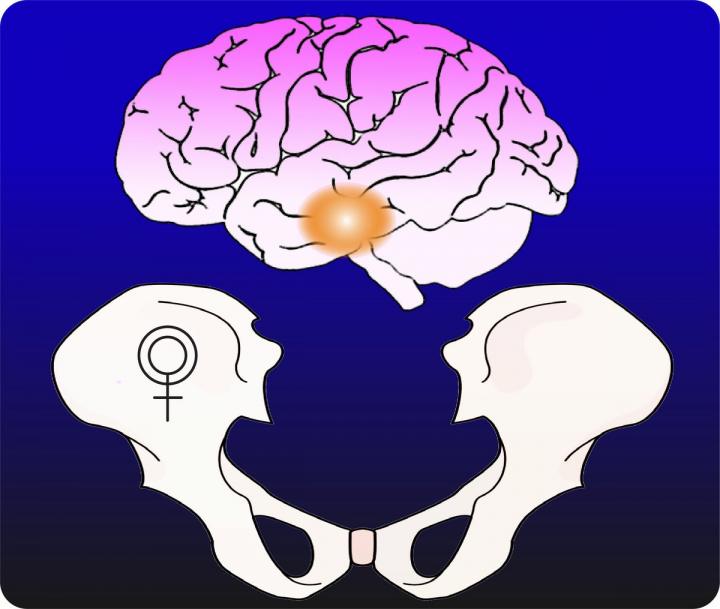Discovery of enhanced bone growth could lead to new treatments for osteoporosis

Blocking signals from a small number of neurons in the brain produces bone growth in female mice. Credit: Holly Ingraham/UC San Francisco
UCLA and UC San Francisco life scientists have discovered a dramatic pattern of bone growth in female mice — research that could potentially lead to stronger bone density in women and new treatments for osteoporosis in older women.
The researchers found that blocking a particular set of signals from a small number of neurons in the brain causes female, but not male, mice to build super-strong bones and maintain them into old age. These neurons may play an important role in controlling women's bone density, the researchers said. The study was published Jan. 11 in the journal Nature Communications.
“We think we have identified a new pathway by which the brain regulates bone density that holds great promise because it allows the body to shift new bone formation into overdrive,” said co-author Stephanie Correa, a UCLA assistant professor of integrative biology and physiology, and member of UCLA's Brain Research Institute.
More than 200 million people worldwide suffer from osteoporosis, in which bones weaken and can easily fracture. Women are at relatively high risk of osteoporosis after menopause.
Correa said the study highlights the importance of studying females, as well as males. “We would have missed this if we had studied only males,” she said. “The differences between what we see in males and females will give us more clues about how these neurons develop, how they work and what they do. The more we understand about how the neurons work, the closer we will get to manipulating them to improve bone health.”
The study began when Correa, then a postdoctoral researcher in the UCSF laboratory of study senior author Holly Ingraham, found that genetically deleting the estrogen receptor protein in neurons in a brain region called the hypothalamus caused altered mice to gain a slight amount of weight, and become less active.
Correa expected to find that the animals had put on extra fat or gained lean muscle, but neither of these was the case. To learn the source of the extra weight, she used more sensitive laboratory techniques that could reveal changes in bone density.
To her surprise, she discovered that the heavy mice were large-boned. Ingraham's laboratory showed that their bone mass had increased by as much as 800 percent.
“I was immediately struck by the size of the effect,” Correa said. “We knew right away it was a game-changer and presented a new, exciting direction with potential applications for improving women's health.”
In addition, the super-dense bones were exceptionally strong.
“Our collaborators who study bone for a living said they'd never seen bone this strong,” said Ingraham, UCSF professor of cellular and molecular pharmacology. “Our current understanding of how the body controls bone growth can't explain this, which suggests we may have uncovered a completely new pathway that could be used to improve bone strength in older women and others with fragile bones.”
Ingraham's postdoctoral fellows Candice Herber and William Krause conducted experiments that zeroed in on a specific population of just a few hundred estrogen-sensitive brain cells — located in a region of the hypothalamus called the arcuate nucleus — which appeared to be responsible for these dramatic increases in bone density. The authors hypothesized that estrogen must normally signal these neurons to shift energy away from bone growth, but that deleting the estrogen receptors had reversed that shift.
Additional experiments showed that the altered mice maintained their enhanced bone density well into old age. Normal female mice begin to lose significant bone mass by 20 weeks of age, but the altered mice maintained elevated bone mass well into their second year of life, which is considered old for a mouse.
Herber and Krause were even able to reverse existing bone degeneration in an experimental model of osteoporosis. In female mice that had already lost more than 70 percent of their bone density due to experimentally lowered blood estrogen, deletion of arcuate estrogen receptors caused bone density to rebound by 50 percent in a matter of weeks.
The researchers are now studying how this brain-bone communication occurs, and whether drugs could be developed to increase bone strength in post-menopausal women without the potentially dangerous effects of estrogen replacement therapy.
The role of estrogen in the brain is still poorly understood, said Ingraham, whose laboratory studies how the signaling of estrogen in the brain affects female metabolism at different life stages.
###
The research was funded by the National Institutes of Health and a U.S. Department of Veterans Affairs merit review grant.
Media Contact
More Information:
http://dx.doi.org/10.1038/s41467-018-08046-4All latest news from the category: Life Sciences and Chemistry
Articles and reports from the Life Sciences and chemistry area deal with applied and basic research into modern biology, chemistry and human medicine.
Valuable information can be found on a range of life sciences fields including bacteriology, biochemistry, bionics, bioinformatics, biophysics, biotechnology, genetics, geobotany, human biology, marine biology, microbiology, molecular biology, cellular biology, zoology, bioinorganic chemistry, microchemistry and environmental chemistry.
Newest articles

A ‘language’ for ML models to predict nanopore properties
A large number of 2D materials like graphene can have nanopores – small holes formed by missing atoms through which foreign substances can pass. The properties of these nanopores dictate many…

Clinically validated, wearable ultrasound patch
… for continuous blood pressure monitoring. A team of researchers at the University of California San Diego has developed a new and improved wearable ultrasound patch for continuous and noninvasive…

A new puzzle piece for string theory research
Dr. Ksenia Fedosova from the Cluster of Excellence Mathematics Münster, along with an international research team, has proven a conjecture in string theory that physicists had proposed regarding certain equations….



